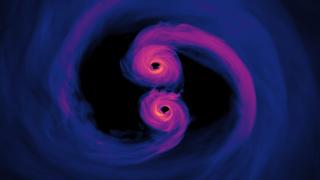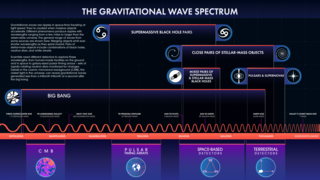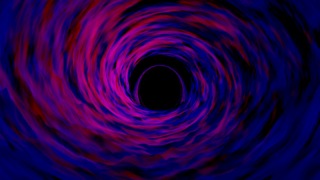Universe
ID: 13086
This new ultra-high definition simulation shows three orbits of a pair of supermassive black holes only 40 orbits from merging. The models reveal the light emitted at this stage of the process may be dominated by UV light with some high-energy X-rays, similar to what’s seen in any galaxy with a well-fed supermassive black hole.
Three regions of light-emitting gas glow as the black holes merge, all connected by streams of hot gas: a large ring encircling the entire system, called the circumbinary disk, and two smaller ones around each black hole, called mini disks. All these objects emit predominantly UV light. When gas flows into a mini disk at a high rate, the disk’s UV light interacts with each black hole’s corona, a region of high-energy subatomic particles above and below the disk. This interaction produces X-rays. When the accretion rate is lower, UV light dims relative to the X-rays.
The simulation is of a system with 1 million times the Sun's mass, and a separation between the two supermass black holes of 30 million kilometers.
The simulation ran on the National Center for Supercomputing Applications’ Blue Waters supercomputer at the University of Illinois at Urbana-Champaign. Modeling three orbits of the system took 46 days on 9,600 computing cores.
Supermassive Black Hole Binary Simulation Visualizations in 4k
Three regions of light-emitting gas glow as the black holes merge, all connected by streams of hot gas: a large ring encircling the entire system, called the circumbinary disk, and two smaller ones around each black hole, called mini disks. All these objects emit predominantly UV light. When gas flows into a mini disk at a high rate, the disk’s UV light interacts with each black hole’s corona, a region of high-energy subatomic particles above and below the disk. This interaction produces X-rays. When the accretion rate is lower, UV light dims relative to the X-rays.
The simulation is of a system with 1 million times the Sun's mass, and a separation between the two supermass black holes of 30 million kilometers.
The simulation ran on the National Center for Supercomputing Applications’ Blue Waters supercomputer at the University of Illinois at Urbana-Champaign. Modeling three orbits of the system took 46 days on 9,600 computing cores.
Used Elsewhere In
Related
For More Information
Credits
Scott Wiessinger (USRA): Lead Producer
Jeanette Kazmierczak (University of Maryland College Park): Lead Science Writer
Scott Noble (USRA/U. Tulsa): Lead Visualizer
Scott Noble (USRA/U. Tulsa): Lead Scientist
Jeanette Kazmierczak (University of Maryland College Park): Lead Science Writer
Scott Noble (USRA/U. Tulsa): Lead Visualizer
Scott Noble (USRA/U. Tulsa): Lead Scientist
Please give credit for this item to:
NASA's Goddard Space Flight Center
NASA's Goddard Space Flight Center
Science Paper:
https://iopscience.iop.org/article/10.3847/1538-4357/aad8b4
Short URL to share this page:
https://svs.gsfc.nasa.gov/13086
This item is part of this series:
Astrophysics Visualizations
Keywords:
SVS >> Simulation
SVS >> UV
SVS >> X-ray
SVS >> Black Hole
SVS >> Astrophysics
NASA Science >> Universe
SVS >> 4K
SVS >> Supermassive Black Hole
https://iopscience.iop.org/article/10.3847/1538-4357/aad8b4
Short URL to share this page:
https://svs.gsfc.nasa.gov/13086
This item is part of this series:
Astrophysics Visualizations
Keywords:
SVS >> Simulation
SVS >> UV
SVS >> X-ray
SVS >> Black Hole
SVS >> Astrophysics
NASA Science >> Universe
SVS >> 4K
SVS >> Supermassive Black Hole














